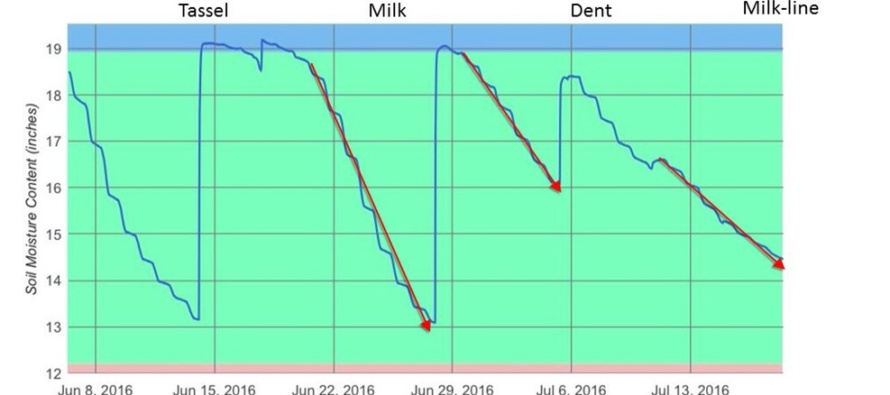How to Determine when you can Terminate Corn Irrigation

Related Articles
- 2010 Soybean And Corn Variety Trial Data 3
- Spring Nitrogen Fertility Suggestions for Wheat 0
- 2010 Row Crop Short Course Video Links 0
Latest Tweets
As the corn crop nears maturity, knowing when you can safely terminate irrigation timing, while optimizing kernel development and yield potential is likely the most important management decision you will face. In order to make this decision, you need to be able to estimate when the crop will reach maturity and how much moisture is present in your soil profile. Improper timing will either limit yield potential or unnecessarily waste money and labor. Fortunately, we can outline the steps needed to help make this process accurate and reliable.
Corn kernels continue to gain size and weight until physiological maturity, so you need to make sure to not terminate management when stress will limit grain fill. Luckily, as kernels progress through the latter stages approaching maturity, there is a method to definitively monitor development.
 Kernels mature from the outside-in when hard starch begins forming at the dent stage. The kernel crown will turn hard and become the bright, shiny, golden yellow color of mature kernels. This starch accumulation will steadily progress towards the base of the kernel (where it attaches to the cob) taking about 20 days to complete. This progression of maturity can be monitored by movement of the milk-line or hard starch. The milk-line is a visual border evident on the seed coat where starch is apparent as a bright, golden yellow color, compared to the buttery tint of the doughy portion of the kernel. To observe the milk line, break an ear in half and observe the cross-section of the top half of the ear, so you are looking at the side of kernels opposite the embryo. If you have difficulty seeing this color disparity between layers, you can confirm its location by simply poking the seed coat with your fingernail into the soft, doughy layer near the kernel base and repeating progressively toward the crown of the kernel, until you feel the hard starch.
Kernels mature from the outside-in when hard starch begins forming at the dent stage. The kernel crown will turn hard and become the bright, shiny, golden yellow color of mature kernels. This starch accumulation will steadily progress towards the base of the kernel (where it attaches to the cob) taking about 20 days to complete. This progression of maturity can be monitored by movement of the milk-line or hard starch. The milk-line is a visual border evident on the seed coat where starch is apparent as a bright, golden yellow color, compared to the buttery tint of the doughy portion of the kernel. To observe the milk line, break an ear in half and observe the cross-section of the top half of the ear, so you are looking at the side of kernels opposite the embryo. If you have difficulty seeing this color disparity between layers, you can confirm its location by simply poking the seed coat with your fingernail into the soft, doughy layer near the kernel base and repeating progressively toward the crown of the kernel, until you feel the hard starch.
You can use the milk-line development to estimate when the crop will reach physiological maturity. The milk-line progression through the entire kernels lasts about 20 days or slightly longer. Alternatively, each quarter of the kernel fills starch over 5-6 days. Therefore, if your milk-line has progressed one-quarter of the way through the kernel, you have about 15 more days to maturity. The formula used to calculate this example is: (20d – (20d x 25% milk line)) = 15 days to maturity.
Once you estimate how long it will take the crop to reach physiological maturity, you must also evaluate your soil moisture reserves to see if you have enough to carry the crop to maturity. You can evaluate moisture using a shovel, probe, auger or other basic methods, but soil moisture sensors are a tremendous help for this purpose. We are confirming or learning several things from soil moisture sensors relevant to this objective:
- Mississippi grown corn is perfectly capable of drawing moisture from at least 36-inches deep at this time, if soils or compaction don’t limit water infiltration or root growth.
- The daily rate of soil moisture loss moderates considerably after dent stage as the corn approaches maturity, compared to early reproductive stages.
This means you can implement a much more conservative schedule and/or likely terminate irrigation much earlier than previously assumed. The new sensor technology may allow you to thoroughly monitor daily moisture level and closely estimate whether you will have enough when the crop reaches maturity. Our sensor results are showing a fully charged soil profile may provide ample moisture for an irrigation cycle of at least 15-18 days after dent stage, compared to 9-12 days during peak water use. The other consideration we should realize and employ, if needed, is that corn’s sensitivity to drought stress decreases substantially near maturity, so we can justify using a much lower irrigation threshold at this time. Therefore, this information is validating research results which seldom show a positive yield response to additional furrow irrigation, if you have a full profile of soil moisture after milk-line movement begins. Conversely, there is little, if any benefit to having an abundant profile of soil moisture at physiological maturity or thereafter. In fact, it may encourage soil compaction during harvest and/or limit the effectiveness of deep tillage later this fall.






Let me tell You a sad story ! There are no comments yet, but You can be first one to comment this article.
Write a comment